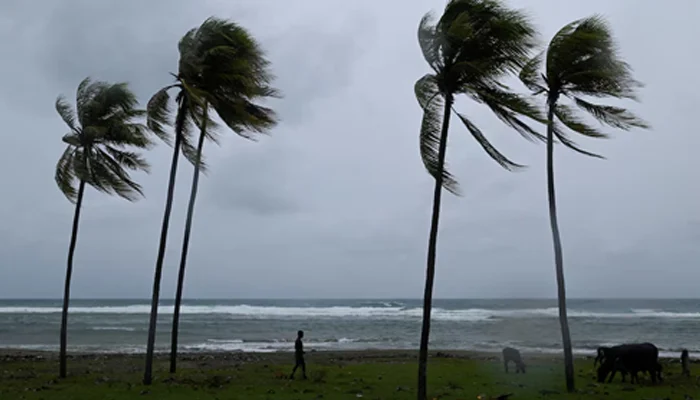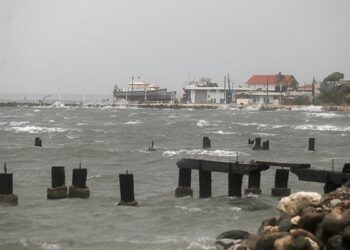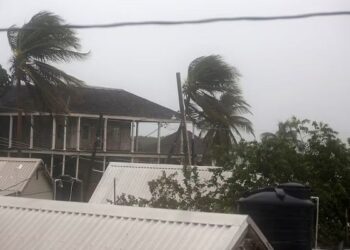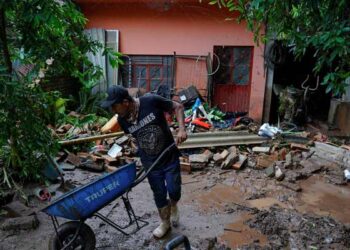Select Language:
A man herds cattle along the shoreline in Santiago de Cuba, Cuba, on October 28, 2025, as Hurricane Melissa approaches landfall. — Reuters
– The storm has left hundreds of thousands of Jamaicans without power.
– Some areas in western Jamaica have been submerged underwater, according to officials.
– Hurricane Melissa follows last year’s Beryl, which heavily impacted Jamaica.
Hurricane Melissa advanced toward Cuba’s second-largest city as a formidable Category 4 hurricane early Tuesday, just hours after making landfall in Jamaica—marking the strongest cyclone ever recorded to hit the island nation.
Melissa made landfall near New Hope in southwestern Jamaica, with sustained winds reaching 185 mph (295 kph), according to the US National Hurricane Center. This wind speed exceeds the 157 mph (252 kph) threshold required for a Category 5 classification—the highest category on the Saffir-Simpson scale.
In Jamaica’s St. Elizabeth parish, floodwaters overtook the area, and over 500,000 residents lost their power. Prime Minister Andrew Holness reported to CNN that damage includes destruction of hospitals, significant harm to homes and businesses, and damage to road infrastructure. While no confirmed storm-related deaths have been reported, Holness cautioned that, given Melissa’s force and destruction, some loss of life is anticipated.
Winds have decreased slightly to 145 mph (233 kph) as Melissa drifts over the mountainous terrain of Jamaica, threatening landslides and flooding in highland communities. The storm is expected to veer northeast toward Santiago de Cuba, Cuba’s second most populous city.
Cuban President Miguel Diaz-Canel issued a warning, stating, “We should already feel the cyclone’s main impact this afternoon and evening,” and urged residents to follow evacuation orders. Cuba has instructed approximately 500,000 people to relocate to higher ground. Meanwhile, in the Bahamas, officials ordered evacuations in southern regions as Melissa’s path takes it northeast. Some parts of Hispaniola, shared by Haiti and the Dominican Republic, have experienced days of intense rainfall, causing at least four fatalities.
There have been reports of at least three deaths in Jamaica during storm preparations, and a disaster management official suffered a stroke during the storm’s onset and was hospitalized. Many areas remain isolated as of late Tuesday.
Jamaica, no stranger to hurricanes, had never before been directly hit by such a powerful Category 4 or 5 storm, prompting the government to call for international aid even as they prepared for Melissa’s arrival.
Meteorologists from AccuWeather ranked Melissa as the third most intense hurricane in the Caribbean after Wilma (2005) and Gilbert (1988)—the last major landfall storm in Jamaica. Anne-Claire Fontan, a tropical cyclone expert with the World Meteorological Organization, described the situation as “catastrophic,” warning of storm surges reaching up to four meters high. She referred to Melissa as “the storm of the century” for Jamaica.
Aid worker Colin Bogle, based near Kingston, reported hearing a loud explosion before losing power and witnessing trees violently tossed by the storm. He described the experience as “like a roaring lion,” filled with fear and frustration over ongoing climate crises affecting Jamaica, which is often hit by such devastating weather events.
Climate scientists warn that hurricanes are growing stronger and more frequent due to rising ocean temperatures. Many Caribbean leaders have urged wealthy nations to provide reparations, including aid and debt relief, to help these island nations cope with climate-related disasters.
Melissa’s size and intensity increased over the unusually warm Caribbean waters, while its slow movement has the potential for significant destruction. Relief efforts will require urgent food aid, equipment, transportation parts, and seeds for farmers, especially since Melissa crossed some of Jamaica’s most productive agricultural zones, similar to last year’s Beryl.
Prime Minister Holness stated Monday that the government has set aside a $33 million emergency budget, along with insurance and credit facilities, prepared to cover damages exceeding those caused by Beryl.
Melissa first made landfall in southwestern Jamaica, near the boundary between Westmoreland and St. Elizabeth, regions severely affected by Beryl. Floodwaters inundated St. Elizabeth, and its sole public hospital lost power and sustained severe damage. Rescue teams managed to reach stranded families, including those with infants.
In Portland Cottage, about 150 km (94 miles) from the epicenter, 64-year-old retiree Collin Henry McDonald reported heavy rain and winds but noted his concrete roof held firm. He described the storm as “like a roaring lion, really mad.”
By late Tuesday, approximately 15,000 Jamaicans were in emergency shelters, with the government ordering mandatory evacuations for 28,000 residents—many reluctant to leave their homes. The Red Cross estimates that up to 1.5 million Jamaicans could be directly affected.







